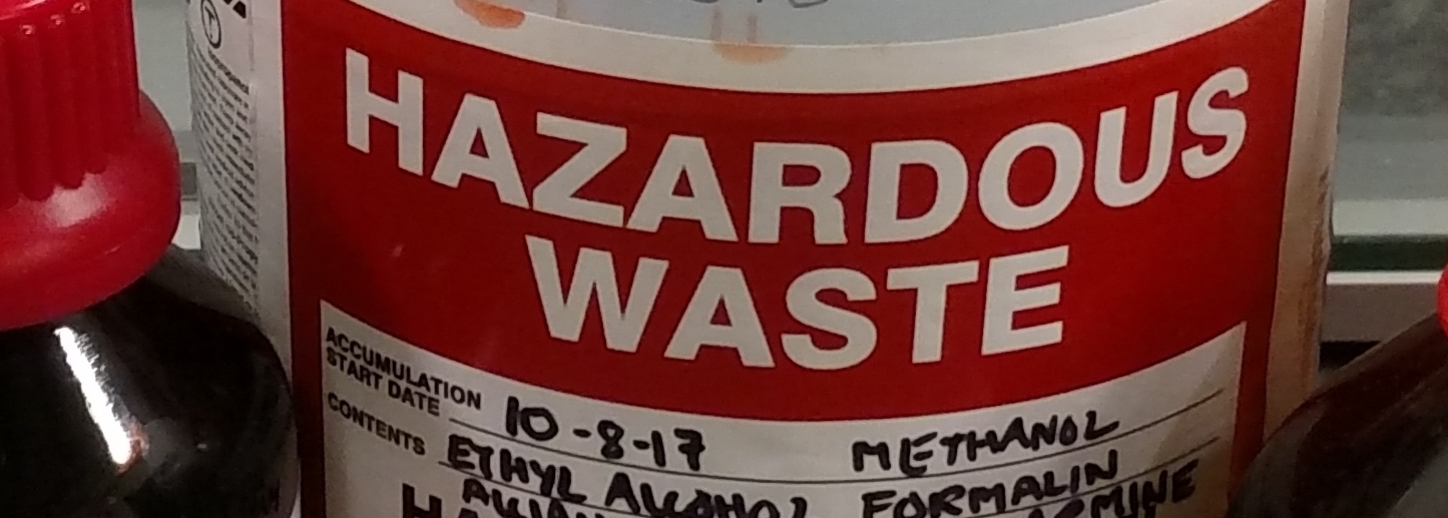
Waste Management
Regulated wastes can be classified into two categories: Hazardous Waste or Universal Waste / Non-Hazardous Waste.
Waste streams for each department have been setup, so that any waste that is generated can be properly handled and disposed of. Please see list of the most common items that cannot go down the drain.
The waste management plan will be followed when disposing of wastes on campus. All regulatory requirements will be followed to ensure compliance with all federal, state and local laws and ordinances.
Hazardous Waste material can have severe effects on personal health and the environment, they are materials that can be defined as flammable, corrosive, reactive or toxic.
It can include items like but not limited to:
Chemicals used in laboratories
Cleaning fluids
Ink used in printing (flammable)
Pesticides
Oil based products (lubricants, paint)
Propellant or non-propellant flammables
Polychlorinated Biphenyl (PCB) containing electronics
Universal and Non-Hazardous Waste is a classification of hazardous waste which contains items the EPA defines as being very common. They require special handling and cannot be disposed of in the regular trash. These are materials that can be recycled.
It can include but are not necessarily limited to:
Batteries (Collected by Chemical Hygiene Officer)
1. Alkaline, Please use a separate container for rechargeable batteries
2. Nickel cadmium, lithium ion, lead, etc., Place tape over terminals on batteries above 6V
Used Oil (Collected by Facilities)
Antifreeze (Collected by Facilities)
Electronic Waste (discarded computers, laptops, and small office equipment) - non-PCB (Collected by Information Technology)
Spent Fluorescent Bulbs (Collected by Facilities)
Water Based Paint (Collected by Facilities)
Satellite Accumulation Containers
Satellite accumulation containers are located in various laboratories the generate waste. Please call 920-403-4019 or email mark.musser@snc.edu if your waste container is full. Always list container contents to make it more cost effective to dispose of.
Most Common Items That Cannot Go Down the Drain
- Flammable liquids. Acetone, Benzene, 2-Propanol (Isopropyl alcohol), Cyclohexane, Ethyl Acetate, Hexane, Isopentanol, Methanol and Toluene.
- Corrosive liquids (pH lower than 5.0 or higher than 9.0). Ammonium hydroxide (Ammonia) Hydrochloric acid, Nitric acid, Phosphoric acid, Potassium hydroxide, Sodium hydroxide and Sulfuric acid.
- Toxic liquids or solids. Barium, Copper (II) sulfate, Chromium, Lead (II) Nitrate, Mercury, Nickel, Silver and Zinc.
- Any solid or viscous in quantities or of such size capable of causing obstruction to the flow in the sewers.
- Color that cannot be removed by the treatment system. Such as but not limited to: dye wastes, commercial inks, water-based inks and dyes.
- Any substances regulated as hazardous waste under federal or state law.
- Used anti-freeze, motor oil, brake fluid, transmission fluid, hydraulic fluid, oil-based paint and paint thinners. Always collect these items in a properly labeled compatible container.
For a complete list of the De Pere Municipal Code Section 70-5.
Disposal Location - Brown County Hazardous Material Recovery Facility
The primary purpose of the Hazardous Materials Recovery Program is to provide a safe disposal outlet for hazardous material from Brown County residents, and businesses that are very small generators of hazardous waste.
- Businesses may call 920-942-4950 to arrange and appointment
Disposable Items List and Fees
Brown County Hazardous Material Recovery Facility - https://www.browncountyrecycling.org/
2561 South Broadway, Green Bay WI 54304
Proper Disposal of Wastes
Improper disposal can have severe effects on landfill operations and the environment.
Recycling
Recycling is the fifth choice after Reject, Reduce, Reuse, Repair on the Brown County Resource Recovery website. Recycling reduces the amount of items being disposed of in a landfill, but it still takes energy to convert it back into a usable item.
Commonly recycled materials include: aluminum cans, cans(tin), electronic equipment, glass bottles, paper, plastics, and metal.
If you have any disposal questions, please contact Mark Musser, chemical hygiene officer, located in the Gehl-Mulva Science Center (GMS) at 920-403-4019 or mark.musser@snc.edu. Please make arrangements to handle your Universal or Hazardous Waste needs before showing up at the office with various quantities of materials.
Your attention in these matters are Greatly appreciated!













